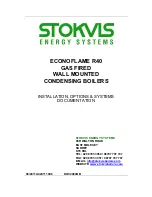
Norms and regulations
Maintenance
Fuel
Combustion air
Water quality
10
Maintenance
Regular maintenance is necessary to
secure a safe and economical
operati
on of the installation. For the
R40, one annual maintenance visit is
recommended. During this visit, the
proper functioning of the complete hea-
ting system should be checked as well.
Water quality
The lifetime of the complete heating
system is affected by the water quality.
Additional costs for water treatment of
an installation are always lower than
repairing costs for damage created by
poor water quality.
Fuel
The gas condensing boiler R40
is applicable for natural gases G20 and
G25 and for LPG G31. Factory settings
are always done for G20. For other
types of natural gas, a correction can
be made on the gas valve. For LPG, it’s
necessary to change the gas injector
(included in delivery) before operating
the boiler.
The R40 can work with gas pressures
up to 50 mbar. In case of a gas pressu-
re above 50 mbar, a pressure regulator
should be fitted in the gas line.
The gas consumption and gas pressu-
res of the different gases can be found
in the chapter
"
Technical data
"
.
Combustion air
The gas condensing boiler R40 can be
used in both non-roomsealed and
roomsealed applications. The com-
bustion air to the boiler shouldn’t con-
tain high concentrations of dust and/or
halogen, as they can damage the heat
exchanger surface. Especially in buil-
dings, where chemicals are used, the
combustion air facility should prevent
these chemicals to enter the boiler.
The different room sealed connection
possibilities the R40 is approved for,
can be found in the chapter
"
Flue gas
system
"
.
The following water quality levels must
be respected at all times for warranty
claiming. Damage to the boiler due to
poor water quality will not be taken
un
der warranty.
The system should be filled with water
with a PH value between 8,0 and 9,5.
The chloride value of the water should
not exceed 50 mg/l. Entry of oxygen
by diffusion should be prevented at all
times. Damage to the heat exchanger
because of oxygen diffusion will not
be taken under warranty.
Boiler output
[kW]
Max. sum of alkaline earths
[mol/m
3
]
Max. total hardness
[ºdH]
50 - 200
2.0
11.2
200 - 600
1.5
8.4
Concentrate
Ca(HCO
3
)
2
Capacity of installation Q (kW)
150
200
250
300
400
500
600
mol/m
3
ºdH
Maximum water (re)fill volume V
max
[m
3
]
≤
0.5
≤
2.8
-
-
-
-
-
-
-
1.0
5.6
-
-
-
-
-
-
-
1.5
8.4
3
4
5
6
8
10
12
2.0
11.2
3
4
5
6
6.3
7.8
9.4
2.5
14.0
1.9
2.5
3.1
3.8
5.0
6.3
7.5
≥
3.0
≥
16.8
1.6
2.1
2.6
3.1
4.2
5.2
6.3
In installations with higher water volu-
mes, it’s necessary to respect the maxi-
mum filling and additional volumes with
corresponding hardness values as sta-
ted in the german VDI2035 standard. In
the table you can find the nominal va-
lues for filling and additional water for
the R40 according to the the VDI2035.
The table
on
the left gives an indication
of the relation between the water
quali
ty and the maximum water filling
volu
me during the lifetime of the boiler.
Consult the original text of the VDI2035
for more detailed information.
Constant entry of oxygen in the instal-
lation should be avoided. The system
water pressure should be higher than
the atmospheric pressure in all parts of
the installation. Underfloor heating
components without oxygen diffusion
barrier should never be used. When
they’re used anyway, a system
separa
tion (
e
.
g
. with plate heat
exchanger) is
compulsory.











































